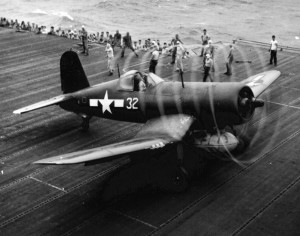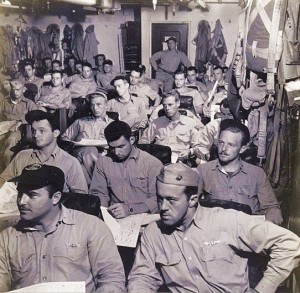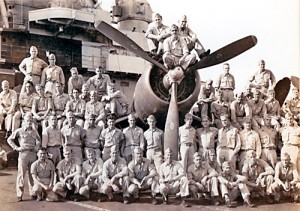On December 18, 1944, during a meeting in Washington D.C., to discuss the nature of carrier operations in the Pacific, Vice Admiral John H. Towers highlighted the phases of the war. The Deputy Commander-in-Chief, Pacific Fleet, who was the Navy’s third aviator, cited the largely completed phase one as a period of engaging enemy vessels and aircraft. “We are now in the second phase where we are attacking enemy shore installations and combating their very violent efforts to damage our carriers and other ships by attack with shore based aircraft,” he wrote in summarizing his remarks for his official diary. By that time in the war, the Japanese had introduced their deadly kamikazes and Towers noted that the operational requirements of phase two called for “a great preponderance of fighter aircraft.”
Part of the effort to bolster the number of fighters on board carriers came to fruition just ten days later when personnel and aircraft of Marine Fighting Squadrons (VMF) 124 and 213 reported to the carrier Essex (CV 9) anchored at Ulithi Atoll. Though leathernecks were already operating from escort carriers, which provided close air support for island invasions in addition to other duties, VMF-124 and VMF-213 represented the first Marine
squadrons assigned to operate from the Navy’s large deck fleet carriers. Equipping the squadrons were thirty-six F4U-1D Corsairs, the famed gull-winged fighter that had become symbolic of Marine aviation with operations in the Solomon Islands and over Rabaul. Adapted for use as fighter-bombers, the -1D version of the Corsair boasted Pratt & Whitney R-2800-8W engines with water injection and fittings for a fuel tank for long-range flights, and two 1,000 lb. bombs or eight 5-inch rockets under the wings.
The inherent danger of carrier operations became readily apparent after Essex put to sea, with operational accidents claiming the lives of two Marine lieutenants. The baptism of fire came on January 3, 1945, when VMF-124 Corsairs provided combat air patrol for a strike against Formosa, strafing aircraft on the ground and claiming the Essex Marines’ first kill, credited to squadron skipper Lieutenant Colonel William A. Millington, who splashed a twin-engine Kawasaki Ki-45 Toryu fighter, codenamed “Nick” by the Allies. In subsequent days, the Marines joined their Navy counterparts in the intense operational schedule consisting of strikes against the Philippines, French Indochina, and Formosa. On January 20, 1945, VMF-124 and VMF-213 aviators were credited with shooting down eight Japanese aircraft, but the following day kamikazes made it through the fleet’s defenses,
hitting the carriers Ticonderoga (CV 14) and Langley (CVL 27). At the end of the first month of combat operations, indicative of the intensity of wartime operations, the two Marine squadrons had lost 19 aircraft with three pilots killed in action and five more missing and presumed killed.
February would provide no respite as the fast carriers launched the first strikes by carrier-based aircraft against the Japanese Home Islands since the Doolittle Raiders took off from Hornet (CV 8) in April 1942. VMF-124 and VMF-213 claimed nine kills over the course of two days of strikes in bad weather on February 16-17, 1945. On February 19th, the Marine pilots launched from Essex to support the invasion of Iwo Jima, hammering Japanese positions on and around Mt. Suribachi. March 1st brought action over Okinawa, strafing Japanese aircraft at Naha. “All our boys in 124 got back O.K. however, except for a few holes of course,” one of that squadron’s pilots recorded in his diary. It was the last combat action for VMF-124 and VMF-213, which were detached when Essex returned to Ulithi. On their last day aboard, they assembled for a photograph on the flight deck, surrounding one of the Corsair in which they had made history.


